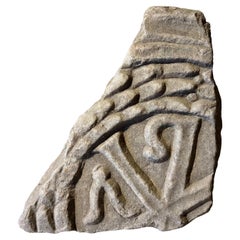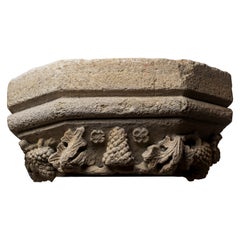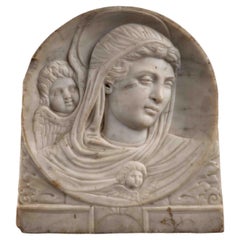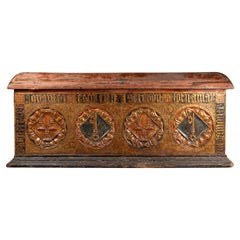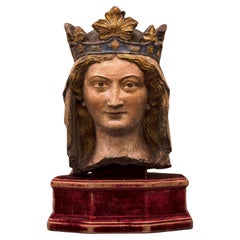Antiques in Brussels
1
to
9
1,534
1,241
3,495
2,074
1,078
864
784
557
501
373
261
249
184
158
119
99
96
83
72
62
49
47
37
34
33
26
19
15
14
12
11
4
3
3
3
2
2
2
2
2
1
1
1
1
1
1
Period: 15th Century and Earlier
Marble Roman relief representing a Christogram
Located in Bruxelles, BE
Marble Roman relief representing a Christogram
Roman relief - 4th century
25 x 22 x 8 cm
Provenance :
Collection of the Château de B. À Nevers by Georges C.S., scholar born in 1833 and deceased in 1909
The entire castle and its collections were acquired in 1938 by the current owners of the estate
A christogram is a monogram or combination of letters that forms an abreviation for the name of Jesus Christ.
This rare fragment combines chi (X) and rho (P), the first two letters of Christ's name in Greek and it is one of the oldest and most popular early christian symbol. The monogram of Christ, or chrismon, is also a powerful symbol of imperial victory: it appeared to Emperor Constantine the Great before his battle against Maxentius in ad 312, promising victory in the name of Christ. In Plato's Timaeus, it is explained that the two bands which form the "world soul" (anima mundi...
Category
15th Century and Earlier Italian Classical Roman Antique Antiques in Brussels
Materials
Marble
Large Hexagonale Base of Pilaster in Burgundy Stone, Burgundy, 15th Century
Located in Bruxelles, BE
Large base of molded hexagonal pilaster in burgundy stone carved with vines, grapes and rosettes in high relief.
Burgundy, 15th century
28 x 63 x 30 cm
Provenance : collection De...
Category
15th Century and Earlier French Gothic Antique Antiques in Brussels
Materials
Stone
Roman Corinthian Capital, Flavian Period, 1st Century AD
Located in Bruxelles, BE
Roman corinthian capital
Marble
Flavian period, 1st century AD
H 40 x L 42 x P 40
Provenance : Private collection United Kingdom.
Category
15th Century and Earlier Italian Classical Roman Antique Antiques in Brussels
Materials
Marble
Renaissance Marble Relief - Emilia Romagna, 1470-80
Located in Bruxelles, BE
Renaissance Marble Relief
Emilia Romagna, Faenza ? 1470-80
H 30,2 x L 33 x P 3,5 cm
The carved marble relief depicts the Virgin accompanied by a winged cherub standing behind her. ...
Category
15th Century and Earlier Italian Renaissance Antique Antiques in Brussels
Materials
Marble
Rare pastiglia marriage chest - North of Italy, First half of 15th century
Located in Bruxelles, BE
Rare pastiglia marriage chest
North of Italy, Liguria or Piemonte
First half of 15th century
wood, gesso, partly gilded, form molded and painted
67 x 156 x 63 cm
Provenance :
Pri...
Category
15th Century and Earlier Italian Renaissance Antique Antiques in Brussels
Materials
Gesso, Wood
Gothic crowned Head - Île de France, 14th century
Located in Bruxelles, BE
Head of a crowned Virgin
Île-de-France, first half of 14th century.
H26 x 14 x 14 cm
Provenance :
- Private Collection, Paris France (1960)
- Private Collection Tuscany, Italy (19...
Category
15th Century and Earlier French Gothic Antique Antiques in Brussels
Materials
Stone
Attributed to Domenico di Paris - Madonna and The Child, 15th century
Located in Bruxelles, BE
Attributed to Domenico di Paris, also called Domenico del Cavallo ( Monselice, documented in Ferrara between 1442 and 1501)
Madonna and The Child
Polychromed and gilded Stucco
47,5 ...
Category
15th Century and Earlier Italian Renaissance Antique Antiques in Brussels
Materials
Stucco
Telamon - Northern Italy, late 12th (Reemployed Roman marble)25000
Located in Bruxelles, BE
Telamon
Northern Italy, late 12th - early 13th century
Reemployed Roman marble
H 32 x L 18 x P 17 cm
« Sono coloro che hanno dimenticato che l’uomo é solo un bruco, destinato a dive...
Category
15th Century and Earlier Italian Medieval Antique Antiques in Brussels
Materials
Marble
Embriachi workshop marquetry casket - Northern Italy, 15th century
Located in Bruxelles, BE
Embriachi workshop marquetry casket
Northern Italy, 15th century
Alla certosina inlays (bone, stained bone, pewter and wood)
H 28.2 x W 18 x D 14 cm
This beautiful casket of rectangular form is richly decorated with the characteristic geometric patterns of the Embriachi style.
The intricate geometric patterns are fashioned by juxtaposing lighter and darker pieces of wood, (colored) bone, horn and pewter. The lid and base are framed by a broad band of horn. When ivory became scarce in Europe due to disrupted trade routes, bone was substituted.
The attention to Symmetry and balance created an harmonious visual effect
Enhancing the overall aesthetic appeal of the casket.
The application of geometrical motifs is in Italy known as marquetry ‘alla Certosina’, named after the Certosina Church in Pavia with its famous altarpiece decorated in this way. This is ‘intarsia technique’, a term derived from the Arabic 'tarsi', which means ‘incrustation' recalling ancient mosaics made from various materials.
These geometric elements not only enhance the aesthetic appeal of the caskets but also demonstrate the versatility and skill of the artisans in creating multifaceted works of art.
‘Alla Certosina’ became famous through the Northern Italian Embriachi family who achieved a particularly high standard in working in this technique. Venice in particular was known for the production of these luxurious boxes. The caskets, hexagonal or rectangular, surmounted by a lid decorated in several registers constitute the secular, albeit equally renowned component of the workshop’s production, in addition to mirror frames and various everyday objects.
The method of fabrication of those objects was based on two concepts that underlay pre-industrial production: standardization and modularity, thanks to a distribution of skills according to the different phases of fabrication.
even the realization of the marquetry motifs (in the form of ingots from which portions of the desired size were cut) were therefore entrusted to various specialized craftsmen, as were the assembly phase.
Today better known thanks to the extensive research work recently carried out by Michele Tomasi, this workshop owes its name to its founder and owner, the Florentine Baldassare Ubriachi (or degli Embriachi), a merchant and banker established in the Tuscan capital before he settled in Venice in 1395. Together with sculptor Giovanni di Jacopo, who directed the workshop, from the last years of the fourteenth century, Baldassare oversaw a production that was truly original, and still easily recognizable today, comprising monumental altarpieces and various objects, primarily triptychs and caskets.
The precise location of the workshop is unknown, except that it originated in Florence and in ca. 1431 there was apparently a workshop in Venice, in the area of S Luca. They employed local workers specializing in 'certosina' (inlay of stained woods, bone and horn), and the workshop produced items carved in bone (usually horse or ox) with wood and bone marquetry.
The geometric decoration of Embriachi caskets reflects the artistic complexity and attention to detail that characterized their work.
this inlaid casket is a testament to the skill and artistry of the Embriachi family and serves as a stunning example of the decorative arts of the late Middle Ages.
Related Literature :
E. Berger, Prunk-Kassetten: Europäischen Meisterwerke aus acht Jahrhunderten / Ornamental Caskets...
Category
15th Century and Earlier Italian Renaissance Antique Antiques in Brussels
Materials
Pewter
A pierced Flamboyant canopy - North of France, 15th century
Located in Bruxelles, BE
A pierced Flamboyant canopy
North of France, 15th century
Limestone
30 x 32 x 35 cm
This richly decorated canopy of circular plan, consist of three carved faces, each dominated by ...
Category
15th Century and Earlier French Gothic Antique Antiques in Brussels
Materials
Limestone
Cercle of Jacopo della Pila - Marble relief depicting a winged Cherub
Located in Bruxelles, BE
Cercle of Jacopo della Pila (Lombard, in Naples 1471-1502)
Marble relief depicting a winged Cherub
Naples, second half of15th century
40 x 57 x 12 cm
Exquisitely carved, this relief portrays a winged cherub with cascading hair and delicate features. The cherub's plump, smooth countenance, rounded cheeks, outlined lips, and finely drawn nose emanate a sense of tenderness. The quadrangular module, is adorned with a carved frame. The relief ascends gradually, transitioning from the low relief of the wings to the high relief of the head.
The rectangular frame and the subtly curved form of the artwork suggest that the relief likely adorned the upper part of an arch or a vaulted chapel. The type is that of the perspective room with a coffered ceiling decorated with figures of winged cherubs, which is found in various Neapolitan chapels of the 15th century. Coffered ceilings attest to the recovery of antiquity and the search for luxury in Renaissance architecture, first in Florence, then in Rome and Naples. The majority of the numerous family chapels and tombs built during the late fifteenth century in south of Italy employ the new formal vocabulary of the Florentine Renaissance in a self-confident manner that permitted a broad spectrum of variations.
The escalating admiration for the classical world, coupled with the development of perspective, significantly contributed to the Renaissance endorsement of coffered ceilings. This artistic and constructive device drew inspiration from the intricate marble patterns observed in historical landmarks such as the Arch of Titus, the Temple of Vesta in Tivoli, the Pantheon, and the Basilica of Maxentius. A distilled product of both mathematical and artistic cultures, deeply scrutinizing the ancient world, the coffered ceiling plays a vital role in the perspective construction of space with its regular and directional geometry. The motif of the coffered ceiling decorated with cherubs in relief was introduced in Naples by Francesco Laurana in the plastic decoration of the Arch of Castelnuovo. Laurana's impact on the art scene in the south of Italy was profound. The introduction of the winged cherub into the region's artistic vocabulary bridged the gap between the classical and the contemporary, creating a synthesis that resonated with both aesthetic and spiritual sensibilities. His influence extended beyond the immediate visual appeal, shaping the cultural identity of the Renaissance in southern Italy. Although the plastic decoration of the Arch of Castelnuovo cannot certainly be ascribed to a mature Renaissance style, it was precisely on this occasion that the sculptors who worked there could get to know and export throughout the Italian peninsula that type of "Florentine classicism" which, even in the 15th century Naples, was conditioned by the Burgundian culture imported into the Kingdom by Alfonso of Aragon himself, with artists called from Spain and Northern Europe. The coffered ceiling, with its geometric patterns and Laurana's winged cherubs nestled within, became a symbol of refinement and cultural sophistication. The relief sculptures, carefully integrated into the overall design, transformed the ceiling into a celestial realm, inviting viewers to contemplate the divine while immersed in the grandeur of the Renaissance space.
Similar winged cherubs appears also in the Naples cathedral. Within the renowned Succorpo Chapel, a mesmerizing marble coffered ceiling adorned with cherubs epitomizes the splendor of the Neapolitan Renaissance. The interplay of light and shadow on the textured surface of the marble coffered ceiling introduces an ethereal dimension, providing an immersive visual experience for observers. The geometric precision and the repeated patterns, reminiscent of classical motifs, establish a sense of harmony and balance that has become the hallmark of the Neapolitan interpretation of Florentine Renaissance aesthetics.
Although probably intended to be admired from a distance, this cherub is intricately detailed and exquisitely rendered: the face and hair are elegantly outlined and the feathers are textured through juxtaposed lines. The marble, both figurative and decorative, adheres to the principles of balance and restrained ornamentation typical of the « Florentine Classicism ». Harmonious shapes and gracefully orchestrated curves , rooted in the classical repertoire, converge to evoke a sense of ethereal beauty. The surface displays the masterful use of a chisel to intricately carve the feathers and facial features, creating an almost abstract quality.
This work is a testament to a sculptor of great skill and rich figurative knowledge, seamlessly blending classical firmness in contours with a refined treatment of the marble's surface. The combination of tradition and innovation point to a stylistic idiom from Lombardy, in particular we can find some comparaisons with the works of Jacopo della Pila, sculptor of Lombard origin working in Naples in the second half of the 15th century. He is documented there between 1471 and 1502, and is a protagonist of the Aragon Renaissance in the second half of the Quattrocento, together with the other great Northern sculptor active in the kingdom, Domenico Gagini.
the first commission he received dates back to August 9, 1471, when Jacopo publicly committed to sculpting the funerary monument of Archbishop Nicola Piscicelli to be placed in the Cathedral of Salerno. The last known work is an altar ordered on July 29, 1502, by the noble Jacopo Rocco for the church of San Lorenzo Maggiore in Naples. Between these two chronological extremes (1471-1502), we must place the fervent activity of the artist, who had trained in Rome, perhaps under the guidance of Paolo Romano but also engaged in dialogue with other major artists of the city, especially Isaia da Pisa. He enriched his experience in Naples, initially drawing inspiration from the works of Domenico Gagini and later from the Tuscan masterpieces of Antonio Rossellino and Benedetto da Maiano destined for the church of Santa Maria di Monteoliveto. Jacopo della Pila's artistic personality is thus based on a complex interplay of influences, contributing to the definition of a highly personal style.
Close comparaison can be made between our cherub and the winged angels reliefs...
Category
15th Century and Earlier Italian Renaissance Antique Antiques in Brussels
Materials
Marble
Large Medieval inscription
Located in Bruxelles, BE
Large Medieval German Inscription
stone
Germany, 14th century
46 x 83 x 13 cm
Category
15th Century and Earlier German Medieval Antique Antiques in Brussels
Materials
Stone
Romanesque capital with sirens - France 13th century
Located in Bruxelles, BE
Rare romanesque capital with sirens
France, XIII century
Limestone
25 x 28 x 22 cm
This finely carved Romanesque capital, executed in high relief from limestone, features four hyb...
Category
15th Century and Earlier French Medieval Antique Antiques in Brussels
Materials
Stone
Roman Marble Architectural Decoration - 1st / 2nd century AD
Located in Bruxelles, BE
Roman marble architectural Decoration
1st-2nd century AD
14 x 9,5 x 5
on a modern metal stand
Decorated in three sides with vegetal elements, le...
Category
15th Century and Earlier Antique Antiques in Brussels
Materials
Marble
Balsamarium shaped as a Bust of a Black Boy - Roman, 1st – 2nd Century AD
Located in Bruxelles, BE
Balsamarium shaped as a Bust of a Black Boy
Bronze, silver inlaid eyes and lips, Roman, 1st – 2nd Century AD
Provenance:
Private London Collection formed 1965-1975
H 10 cm (4 in...
Category
15th Century and Earlier Italian Classical Roman Antique Antiques in Brussels
Materials
Silver, Bronze
Ecce Homo - Florence, 15th century
Located in Bruxelles, BE
A terracotta bust "Ecce Homo"
Florence, 15th century
53 x 44 x 31 cm
Category
15th Century and Earlier Italian Renaissance Antique Antiques in Brussels
Materials
Terracotta
Pair of Candlesticks, Louis XVI, Gilded Bronze and Griotte Marble
Located in Brussels, BE
Pair of Candlesticks, Louis XVI, Gilded Bronze and Griotte Marble
Category
15th Century and Earlier Antique Antiques in Brussels
Materials
Griotte Marble, Bronze
Virgin and the Child, Mosan Region, Second Half of 13th Century
Located in Bruxelles, BE
A polychrome sculpture depicting the Virgin and the Child
Mosan region, second half of 13th century
Polychrome wood
73 x 29 X 12 cm
Provenance :
Former Belgian private collection from the beginning of the 20th century
This remarkable early artwork portrays the Enthroned Virgin and Child, also known as Sedes Sapientiae, which translates to the 'Seat of Wisdom...
Category
15th Century and Earlier Belgian Medieval Antique Antiques in Brussels
Materials
Wood
Gothic Capital with Foliate Decoration, 13th Century
Located in Bruxelles, BE
Gothic capital with foliate decoration
France, limestone
13th century
16.5 x 17 x 12.5 cm
The leaves are organically arranged around the core of...
Category
15th Century and Earlier French Medieval Antique Antiques in Brussels
Materials
Limestone
Rare Romanesque Capital Representing Daniel in the Lion’s Den, 12th Century
Located in Bruxelles, BE
Engaged Romanesque capital representing Daniel in the Lion’s den
France, 12th century
Limestone
38 x 29 x 18 cm
Provenance : Private coll...
Category
15th Century and Earlier French Medieval Antique Antiques in Brussels
Materials
Limestone
Gothic Canopy, France, 15th Century
Located in Bruxelles, BE
Gothic canopy
France, 15th century
Alabaster, some traces of polychromy
33 x 23 x 20 cm
Provenance:
- Private collection Genève, Switzerland
...
Category
15th Century and Earlier French Gothic Antique Antiques in Brussels
Materials
Alabaster
Monumental Feminine Head - Roman Empire - 3rd-4th Century Ad
Located in Bruxelles, BE
Very large feminine head crowned by a tiara
Roman period, 3rd - 4th century AD
Eastern provinces of the Roman Empire (Palmira?)
gray basalt
H 55 cm
Old collec...
Category
15th Century and Earlier Syrian Greco Roman Antique Antiques in Brussels
Materials
Stone
Double Romanesque Capital, France, 13th Century
Located in Bruxelles, BE
Double romanesque capital decorated with two fantastic animals
France, 13th century
Measures: 26,5 x 38,5 x 14,5 cm.
This rare double cap...
Category
15th Century and Earlier French Medieval Antique Antiques in Brussels
Materials
Stone
Gothic Stone Fragment Representing Vine Leaves, France, 15th Century
Located in Bruxelles, BE
Gothic architectural fragment representing vine leaves
France, 15th century
Sandstone
H 21 x 21 x 17 cm
mounted on a modern metal pe...
Category
15th Century and Earlier French Gothic Antique Antiques in Brussels
Materials
Limestone
Pair of Double Cloister Capitals on Two Columns, Toulouse, 14th Century
Located in Bruxelles, BE
Pair of double cloister capitals on two columns.
Toulouse, Saint Augustin cloister ? , 14th century.
Saint Béat marble
Measures: 195 x 53 x 32 cm
Double marble Saint...
Category
15th Century and Earlier French Medieval Antique Antiques in Brussels
Materials
Marble
4 Doors Cupboard or Wardrobe Gothic Period in Oak, 15th Century
Located in Brussels, Brussels
exceptional and very rare Gothic 4 doors buffet or wardrobe in oak, 15th century period from the north of France.
This rare gothic piece open with 4 stylized plant decoration door, each with its original entrance, lockand hinges each in their original condition.
The sides of the cupboard have carved pannels typical of gothic style furniture...
Category
15th Century and Earlier French Gothic Antique Antiques in Brussels
Materials
Oak
Terracotta Bust of Christ as the Redeemer, 15th Century
Located in Bruxelles, BE
A terracotta bust of Christ as The Redeemer
Tuscany or Emilia Romagna, late 15th century
Measures: 46 x 43 x 21 cm
This powerful, moving bust of...
Category
15th Century and Earlier Italian Renaissance Antique Antiques in Brussels
Materials
Terracotta
Rare Romanesque Capital Depicting Four Africans, Apulia, 13th Century
Located in Bruxelles, BE
Large stone capital carved on each side in strong relief. The basket is covered with two crowns of vertical acanthus leaves which sprout from the astragal and fill the space between ...
Category
15th Century and Earlier Italian Medieval Antique Antiques in Brussels
Materials
Stone
Carved Limestone Balustrade, North of France, First Half of the 15th Century
Located in Bruxelles, BE
Carved Limestone balustrade.
In a modern metal frame.
North of France, Ile de France or Normandy.
End of the 14th century - first half of the 15th century.
Measures: 90 x 62 x 8...
Category
15th Century and Earlier French Medieval Antique Antiques in Brussels
Materials
Limestone
Gothic Baptistery in Stone-Spain
Located in Brussels, Brussels
Baptiphere Gothic period -Spain-Galicia (probably granite)
The baptisphere was at the time attached to a wall
Delivery in Belgium, France and abroad.
Category
15th Century and Earlier Spanish Gothic Antique Antiques in Brussels
Materials
Granite
Element of Gothic Architecture, France or Flanders, 15th Century
Located in Bruxelles, BE
Element of gothic architecture
France or Flanders, 15th century
Measures: 48 x 50 x 17 cm
This element of limestone architecture representing two angels above a Gothic pointed arch, was probably the crowning of a stone tabernacle.
Dressed in an alb tightened at the waist by a belt, the angels keep in their hands the instruments of passion: the crown of thorns, the ladder to descend from the cross...
Category
15th Century and Earlier French Gothic Antique Antiques in Brussels
Materials
Limestone
Monumental Stone Capital Decorated with Coat of Arms, France, 15th Century
Located in Bruxelles, BE
Monumental stone capital carved in high relief with foliage and a central coat of arms.
France, 15th century
34 x 49 x 47 cm
Provenance : Georges Demotte collection, then André Macé, see the photo taken by Demotte in his workshop around 1930.
The foliage that surrounds the central ecu with the details of the stems, ribs and lobes shows a naturalistic attention characteristic of 15th century ornamental carving.
This large capital with vegetable decoration was made during the 15th century in France, probably for a castle as it suggests the presence of the central shield, originally painted and gilded.
The work reveals the exceptional virtuosity of Gothic sculptors who tried giving the illusion of the flexibility of stems and leaves. The kale, which here surrounds the central shield, is a plant characteristic of the exuberance of the flora of the Flamboyant Gothic.
This beautiful capital comes from the collection of Georges Joseph Demotte (1877-1923) famous art dealer of Belgian origin specialized in Medieval...
Category
15th Century and Earlier French Medieval Antique Antiques in Brussels
Materials
Stone, Limestone
Large Capital with Two Animals Holding a Phylactery, France, 15th Century
Located in Bruxelles, BE
Stone capital carved in high relief representing two animals holding a phylactery, probably a lion and a bull.
France, 15th century
Measures: 50 x 75 x 33 cm
Provenance : Geo...
Category
15th Century and Earlier French Medieval Antique Antiques in Brussels
Materials
Stone
